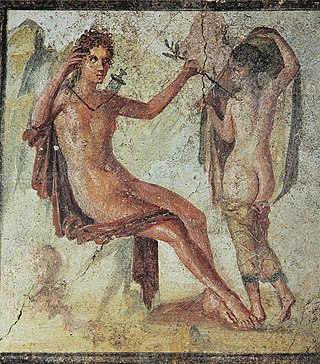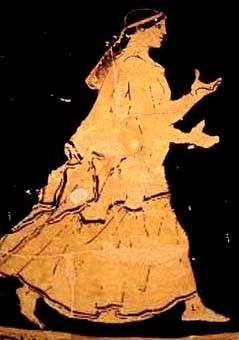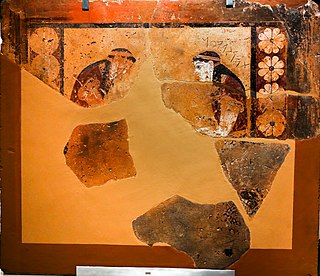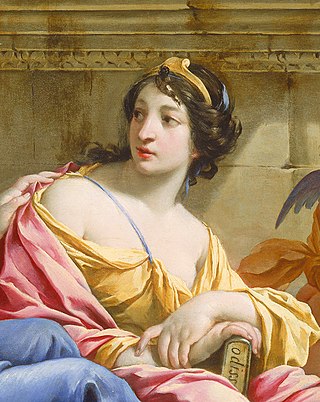After Ovid: New Metamorphoses is a collection of poems inspired by Ovid's Metamorphoses .
Michael Hofmann and James Lasdun, the two editors of After Ovid: New Metamorphoses, commissioned 42 poets from America, Australia, Great Britain, Ireland, and New Zealand to "translate, reinterpret, reflect on, or completely reimagine" Ovid's famous Metamorphoses. [1] The poets include Alice Fulton, C.K. Williams, Mark Rudman, Seamus Heaney [2] and Ted Hughes. [3]

Publius Ovidius Naso, known in English as Ovid, was a Roman poet who lived during the reign of Augustus. He was a contemporary of the older Virgil and Horace, with whom he is often ranked as one of the three canonical poets of Latin literature. The Imperial scholar Quintilian considered him the last of the Latin love elegists. Although Ovid enjoyed enormous popularity during his lifetime, the emperor Augustus banished him to Tomis, a Dacian province on the Black Sea, where he remained a decade until his death.

Io was, in Greek mythology, one of the mortal lovers of Zeus. An Argive princess, she was an ancestor of many kings and heroes, such as Perseus, Cadmus, Heracles, Minos, Lynceus, Cepheus, and Danaus. The astronomer Simon Marius named a moon of Jupiter after Io in 1614.

In Greek mythology, Adonis was a mortal lover of the goddess Aphrodite, and Persephone.

Daphne, a minor figure in Greek mythology, is a naiad, a variety of female nymph associated with fountains, wells, springs, streams, brooks and other bodies of freshwater.

In Greek mythology, Lotis was a nymph mentioned by Ovid.

Myrrha, also known as Smyrna, is the mother of Adonis in Greek mythology. She was transformed into a myrrh tree after having had intercourse with her father, and gave birth to Adonis in tree form. Although the tale of Adonis has Semitic roots, it is uncertain where the myth of Myrrha emerged from, though it was probably from Cyprus.

In Greek mythology, Psamathe is a Nereid, one of the fifty daughters of the sea god Nereus and the Oceanid Doris. By Aeacus, the king of Aegina, she is the mother of a son, Phocus. When Phocus is killed by his half-brothers Peleus and Telamon, Psamathe sends a giant wolf at Peleus' herd.

The Calydonian boar hunt is one of the great heroic adventures in Greek legend. It occurred in the generation prior to that of the Trojan War, and stands alongside the other great heroic adventure of that generation, the voyage of the Argonauts, which preceded it. The purpose of the hunt was to kill the Calydonian boar, which had been sent by Artemis to ravage the region of Calydon in Aetolia, because its king Oeneus had failed to honour her in his rites to the gods. The hunters, led by the hero Meleager, included many of the foremost heroes of Greece. In most accounts it is also concluded that a great heroine, Atalanta, won its hide by first wounding it with an arrow. This outraged many of the men, leading to a tragic dispute.

Philomela or Philomel is a minor figure in Greek mythology who is frequently invoked as a direct and figurative symbol in literary and artistic works in the Western canon.

The Metamorphoses is a Latin narrative poem from 8 CE by the Roman poet Ovid. It is considered his magnum opus. The poem chronicles the history of the world from its creation to the deification of Julius Caesar in a mythico-historical framework comprising over 250 myths, 15 books, and 11,995 lines.
In Greek mythology, Autolycus was a successful robber who had even the power of metamorphosing both the stolen goods and himself. He had his residence on Mount Parnassus and was renowned among men for his cunning and oaths.

In Greek mythology, Calliope is the Muse who presides over eloquence and epic poetry; so called from the ecstatic harmony of her voice. Hesiod and Ovid called her the "Chief of all Muses".
Ibis is a curse poem by the Roman poet Ovid, written during his years in exile across the Black Sea for an offense against Augustus. It is "a stream of violent but extremely learned abuse," modeled on a lost poem of the same title by the Greek Alexandrian poet Callimachus.

In Greek and Roman mythology, Corone is a young woman who attracted the attention of Poseidon, the god of the sea, and was saved by Athena, the goddess of wisdom. She was a princess and the daughter of Coronaeus. Her brief tale is recounted in the narrative poem Metamorphoses by the Roman poet Ovid. Several other myths surround the crow about its connection to Athena.
Nationality words link to articles with information on the nation's poetry or literature.
Elaine Fantham was a British-Canadian classicist whose expertise lay particularly in Latin literature, especially comedy, epic poetry and rhetoric, and in the social history of Roman women. Much of her work was concerned with the intersection of literature and Greek and Roman history. She spoke fluent Italian, German and French and presented lectures and conference papers around the world—including in Germany, Italy, the Netherlands, Norway, Argentina, and Australia.

In Greek mythology, the Hecatoncheires, or Hundred-Handers, also called the Centimanes, named Cottus, Briareus and Gyges, were three monstrous giants, of enormous size and strength, each with fifty heads and one hundred arms. In the standard tradition they were the offspring of Uranus (Sky) and of Gaia (Earth), and helped Zeus and the Olympians to overthrow the Titans in the Titanomachy.

Philip Russell Hardie, FBA is a specialist in Latin literature at the University of Cambridge. He has written especially on Virgil, Ovid, and Lucretius, and on the influence of these writers on the literature, art, and ideology of later centuries.

In Greek mythology Leucothoe was a Babylonian princess. The daughter of Orchamus, a king of Persia, Leucothoe was either a lover of the sun god Helios or a victim of rape. A nymph or Leucothoe's own sister named Clytie, who loved Helios and was jealous of Leucothoe, informed Leucothoe's father that Leucothoe, despite being unmarried, was no longer a virgin, whereupon Orchamus buried his daughter alive in punishment. Helios then transformed Leucothoe's dead body into a frankincense tree.

Themes of transformations are found in all types of mythologies and folklore. Greek mythology features a wide collection of myths where the subjects are physically transformed, usually through either divine intervention or sorcery and spells. Stories of shapeshifting within Greek context are old, having been part of the mythological corpus as far back as the Iliad of Homer. Usually those legends include mortals being changed as punishment from a god, or as a reward for their good deeds. In other tales, gods take different forms in order to test or deceive some mortal. There is a wide variety of type of transformations; from human to animal, from animal to human, from human to plant, from inanimate object to human, from one sex to another, from human to the stars (constellations).